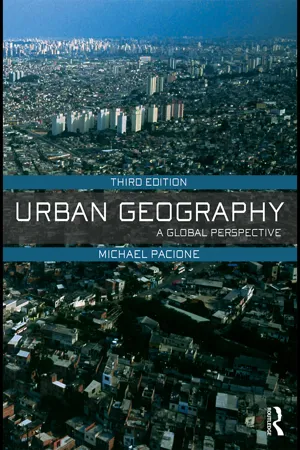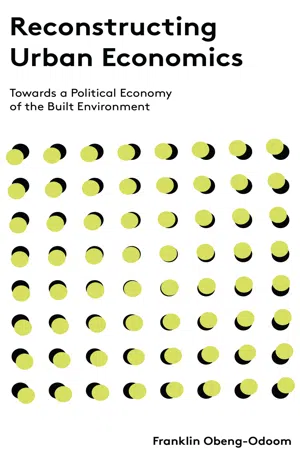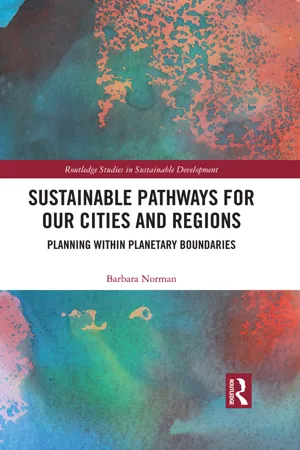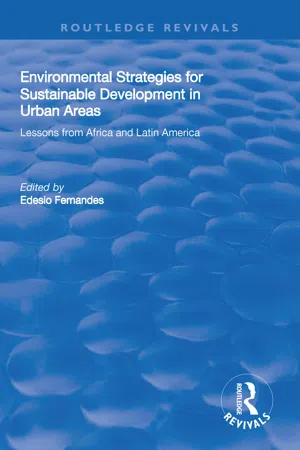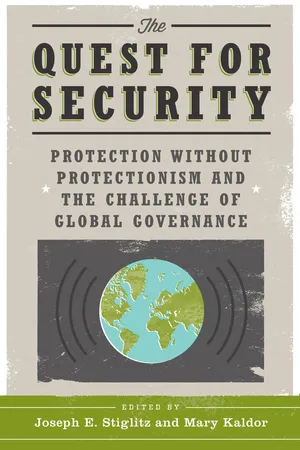Geography
Urban Issues and Challenges
Urban issues and challenges refer to the problems that arise in cities due to rapid urbanisation, population growth, and economic development. These issues include traffic congestion, pollution, housing shortages, poverty, and crime. Urban planners and policymakers work to address these challenges through sustainable development, infrastructure improvements, and social programs.
Written by Perlego with AI-assistance
Related key terms
8 Key excerpts on "Urban Issues and Challenges"
- eBook - ePub
Planning Sustainable Cities
Global Report on Human Settlements 2009
- Un-Habitat(Author)
- 2016(Publication Date)
- Routledge(Publisher)
PART I CHALLENGES AND CONTEXT DOI: 10.4324/9781315541389-1 Chapter 1 Urban Challenges and the Need to Revisit Urban Planning DOI: 10.4324/9781315541389-2 Urban settlements in all parts of the world are being influenced by new and powerful forces that require governments to reconsider how they manage urban futures. Urban areas in both developed and developing countries will increasingly feel the effects of phenomena such as climate change, resource depletion, food insecurity and economic instability. These are all factors that will significantly reshape towns and cities in the century ahead and all of them need to be effectively addressed if cities are to be sustainable, that is, environmentally safe, economically productive and socially inclusive. Many developing countries, in addition, will continue to experience rapid rates of urbanization. With over half of the world’s population currently living in urban areas, 1 there is no doubt that the ‘urban agenda’ will increasingly become a priority for governments everywhere. Since the earliest days of human settlement, people have consciously and collectively intervened in the nature and form of urban areas to achieve particular social, political or environmental objectives. This activity has been known as planning. Over the last century, urban planning 2 has become a discipline and profession in its own right, has become institutionalized as a practice of government as well as an activity of ordinary citizens and businesses, and has evolved as a complex set of ideas which guides both planning decisionmaking processes and urban outcomes - eBook - ePub
Urban Geography
A Global Perspective
- Michael Pacione(Author)
- 2009(Publication Date)
- Routledge(Publisher)
city has an individual character, urban places also exhibit common features that vary only in degree of incidence or importance within the particular urban fabric. All cities contain areas of residential space, transportation lines, economic activities, service infrastructure, commercial areas and public buildings. In different world regions the historical process of urban evolution may have followed a similar trajectory. Increasingly, similar processes, such as those of suburbanisation, gentrification and socio-spatial segregation, are operating within cities in the developed world, in former communist states and in countries of the Third World to effect a degree of convergence in the nature of urban landscapes. Cities also exhibit common problems to varying degrees, including inadequate housing, economic decline, poverty, ill health, social polarisation, traffic congestion and environmental pollution. In brief, many characteristics and concerns are shared by urban places. These shared characteristics and concerns represent the foundations for the study of urban geography. Most fundamentally, the character of urban environments throughout the world is the outcome of interactions among a host of environmental, economic, technological, social, demographic, cultural and political forces operating at a variety of geographic scales ranging from the global to the local.In this book we approach the study of urban geography from a global perspective. This acknowledges the importance of macro-scale structural factors in urban development, but also recognises the reciprocal relationship between global forces and locally contingent factors in creating and recreating the geography of towns and cities. A global perspective also demonstrates the interdependence of urban places in the contemporary world, and facilitates comparative urban analysis by revealing common and contrasting features of cities in different cultural regions. This global perspective resonates with recent transnational1 and postcolonial 2 approaches to urban study. The global perspective eschews the analytical value of simplistic distinctions between cities based on, for example, level of development; rejects prioritisation of knowledge produced in one world region or city over another; and seeks to understand cities by drawing on the richness and diversity of urban experience that characterises our contemporary urban world.While the organisation of this book into sections and chapters is a necessary pedagogic device to bring order to the complex and diverse subject matter of urban geography, the global perspective underlines the interconnections among the different sections, chapters and themes presented. In addition, the global perspective not only promotes integrated insight into our urban world but also encourages readers to ‘think outside the box’ and seek to relate experiences across different urban and cultural realms. - eBook - ePub
Reconstructing Urban Economics
Towards a Political Economy of the Built Environment
- Franklin Obeng-Odoom(Author)
- 2016(Publication Date)
- Zed Books(Publisher)
2 | THE URBAN CHALLENGEIntroduction‘Urban challenge’ is a popular refrain, but there is considerable uncertainty about what the key urban challenge is:Scott and Storper (2015 )show that the responses to this question have changed over time. At the start and in the middle of the 20 th century, the Chicago School of Urban Sociology sought to equate the urban challenge to nurturing an urban ecosystem. All that transformed into equating the urban challenge to a society-wide challenge where there was nothing ‘urban’ about social problems. The accumulation of knowledge and advances in research, however, meant that since the late 20 th century, there has been an intense interest in the ‘urban’ as a legitimate unit of analysis.But that has brought fresh questions about the urban challenge: is it about managing urban growth, urbanisation, the rate of urbanisation, the function, or the form of cities (Yeboah et al., 2013 a;2013 b;Zhang, 2015, p. 5 )? To some, it is getting the so-called ‘urbanisation-economic development’ nexus right (Njoh, 2003;World Bank, 2009), the assumption being that if urbanisation drives economic development then it must be benign. For others, the urban challenge is more about managing population growth expanding ‘rapidly’ or what is known as the ‘over-urbanisation’ and ‘chaotic’ urbanisation problem (Obeng-Odoom, 2010 a;Potts, 2012 a;2012 b). According to Ian Yeboah and his colleagues (2015 , p. 99 ) working on urban systems, ‘The size of an urban population is not necessarily a problem’. Rather, as lucidly stated by another urban systems writer, the urban challenge is more about managing ‘urban centers, their relationships with the surrounding areas, and the interaction between centers’ (McNulty, 1969, p. 162 ) or simply dealing with urban systems (Yeboah et al., 2013 a;2013 b).There are clearly attempts to extrapolate timeless advice from these varied emphases. However, in changing times, falling for this temptation is dangerous. Also dangerous is focusing on one interpretation to the neglect of the others or, when focusing on all interpretations, assuming that these aspects naturally work towards equilibrium. It is safer and more reliable to untangle this complex web of issues, its regional manifestations, how it has evolved, and how it keeps evolving to understand the urban challenge. So, whileSpencer (2015, p. 884 - eBook - ePub
Sustainable Pathways for our Cities and Regions
Planning within Planetary Boundaries
- Barbara Norman(Author)
- 2018(Publication Date)
- Routledge(Publisher)
9). This provides a unique framework for reducing carbon intensity in national economies and outlines practical pathways to make that transition. It shows how this transition can be made in a sustainable and equitable way and be applied in both developed and developing nations. It relies on a major investment in low-carbon technologies and an international market to allow that investment to expand. If implemented as suggested, it could have major implications and benefits for the future planning and design of our cities. The protection of the urban environment is wide ranging and requires consideration of many factors in addition to carbon. When it comes to cities and regions, environmental issues can range from environmental services to governance. The rate and scale of urban change in developing nations provides a rapidly changing context for any public policy response. Underlying these considerations are the concepts of interdependence, interconnection, justice, scale and participation. All are essential for long-term urban and regional sus tainability. As Executive Director of UN Habitat Joan Clos concludes: The analysis of urban development of the past twenty years presented in this first edition of the World Cities Report shows, with compelling evidence, that there are new forms of collaboration and cooperation, planning, governance, finance and learning that can sustain positive change. (UN Habitat 2016 b, Foreword) This discussion has covered a number of contemporary challenges with urban-isation and highlighted some of the key policy responses, including urban governance, strategic planning, deep decarbonisation and integrated place-based actions discussed further in Chapters Four, Five and Six. However, the greatest challenges facing cities are the risks associated with climate change. The two great global challenges facing the world in the twenty-first century are the rapid rate of urbanisation and human-induced climate change - eBook - ePub
Managing Urban Futures
Sustainability and Urban Growth in Developing Countries
- Marco Keiner, Martina Koll-Schretzenmayr(Authors)
- 2016(Publication Date)
- Routledge(Publisher)
Part I The Challenges of Urban Development ProcessesPassage contains an image
Chapter 1 Asian Urbanization and Local and Global Environmental Challenges
Hans J.A. van Ginkel and Peter J. MarcotullioAsia has experienced rapid development and urbanization in the last half of the 20th century. The transformations have reached unprecedented scales. Many indicators have been used to demonstrate the improvement in overall human well-being, notably those advancements related to income, longevity and some health measures, but this only tells part of the story. The great transformations now in process have been accompanied by both local and global challenges to environmental sustainable development. Moreover, there are indications that the challenges will increase in intensity into the future. It is crucially important to identify the dynamics underlying these developments and point to policies that could begin to address their impacts.This chapter describes the economic and urbanization transformations experienced by Asian cities. It then explores some of the local and global environmental challenges that have accompanied these changes. Specifically, for local issues, we identify the ‘infrastructure time-bomb’ – defined as the overburdening of old, out-of-date, and overused basic infrastructure (e.g., water supply and sanitation) – within some of these cities. Future urbanization will only increase the burden on these structures and if not addressed, the situation may grow into a crisis.In order to address these issues, integrated approaches to planning and urban management are needed. We look to specific examples within the Netherlands to see how a small country, characterized by high population density, solved its resource and spatial planning challenges. The results suggest some lessons for Asian cities. Finally, these observations and analyses have encouraged the United Nations University (UNU) to rethink the direction of its Urban Programme. The last section presents thoughts on how this new program will provide research and capacity building to help address these issues. - eBook - ePub
Cities in a Globalizing World
Global Report on Human Settlements
- Un-Habitat(Author)
- 2012(Publication Date)
- Routledge(Publisher)
Together, these processes of change create enormous challenges to traditional ways of understanding cities. They particularly challenge customary views concerning land use, physical form, urban design and transportation; ways of thinking about industrial-age cities that have long neglected the importance of electronic communications and technologies in urban life. 11 In response to such challenges, urban research on ICTs is beginning to grow rapidly. 12 Still, many questions at the intersection of ICTs and human settlements remain largely unaddressed by urban researchers. How, for example, do digitally mediated economic flows articulate with city economies and urban systems in different places and sectors within developed, developing, newly industrializing and post-communist economies? What are the relationships between the application of ICTs and broader processes of social and geographical polarization, discussed earlier in this chapter? How can urban analysis and policy making grapple meaningfully with invisible and intangible domains of electronic flow and real-time exchanges at multiple geographical scales? And how can the policy worlds of the city be brought together with those of cyberspace and ICTs to foster creative policy initiatives that harness the power of new technologies for positive urban social and economic development? Far from ushering us towards societies of reduced inequality, ICTs often support new extremes of social and geographical unevenness within and between human settlements, in both the North and the South The remainder of this chapter demonstrates that dominant trends in ICT development, far from ushering us toward societies of reduced inequality, often support new extremes of social and geographical unevenness within and between human settlements, in both the North and the South - eBook - ePub
Environmental Strategies for Sustainable Developments in Urban Areas
Lessons from Africa and Latin America
- Edesio Fernandes(Author)
- 2019(Publication Date)
- Routledge(Publisher)
Technological communications/information revolution The growing flow of information and improved communication facilities affect cities in at least two unprecedented ways. On the one hand, it affects them externally due to factors such as: improved communications with other cities and other levels of government; access to potentially useful technical information and technologies; possibility of stronger linkages between universities, city administrations, private sector and other institutions, among other potential advantages. On the other hand, it also affects cities internally, especially in so far as the following factors are concerned: potential to improve land registry databases and information about the city; improved communications among internal departments; improved public relations; possibility to increase municipal revenues through more detailed monitoring of property taxes, among other potential advantages.Nowadays, in principle, a student can have as much information as the office of the mayor, which factor can contribute to more democratic urban governance practices. However, it is also important not to mystify technology: software can complement, but it does not substitute human capacity development. All the elements above seem to point to a changing context in which “urban/rural”, “global/local”, “city/countryside”, are not necessarily competing and mutually exclusive aspects, but increasingly complementary in forming a path towards sustainability.A growing challenge: are cities sustainable?
Environmental consequences of urbanization in developing countries
Urbanization in developing countries has been accompanied by an alarming growth in the incidence of poverty and environmental degradation. Today, one out of four urban dwellers lives in absolute poverty; another one in four is classified as relatively poor. By the end of this decade, according to the UN, poor urban households are projected to increase by 76 per cent. This rapid concentration of hundreds of millions of people has placed an extraordinary strain on the ability of governments - both municipal and national - to meet the needs of city dwellers. Urban environmental problems - such as water and sanitation, waste management, public transport and energy - are particularly acute, and growing worse, as available services and resources are overwhelmed by expanding populations. - eBook - ePub
The Quest for Security
Protection Without Protectionism and the Challenge of Global Governance
- Joseph E. Stiglitz, Mary Kaldor(Authors)
- 2013(Publication Date)
- Columbia University Press(Publisher)
But ultimately, I will argue, there is a need, and cities make this need visible and urgent, to go well beyond these governance frameworks. We cannot simply redistribute carbon emissions, nor are mitigation and adaptation directives enough. We need to bring in the knowledge that diverse natural sciences have accumulated, including practical applications, to address the major environmental challenges.At the level of the city, using this knowledge is a far more specific and domain-interactive effort than at the level of national policy. Further, it will entail an internationalism derived from the many different countries that are leaders in these scientific discoveries and innovations. But this will be an internationalism that runs through thick local spaces, each with their own political and social cultures for implementing change. Finally, as I will argue, capturing the complexity of cities in their multiscalar and multiecological composition will allow for many more vectors for implementation than just about any other level, whether national, international, or suburban, such as the neighborhood. This should, in turn, allow us to go well beyond adaptation and mitigation as currently understood.The Urbanizing of Global Governance ChallengesMany of today’s major global governance challenges become tangible, urgent, and practical in cities worldwide. Urban leaders and activists have had to deal with many issues long before national governments and interstate treaties addressed them. Cities are sites where these challenges can be studied empirically and where policy design and implementation often is more feasible than at the national level. Among these global governance challenges are those concerning the environment; human insecurity, including the spread of violence against people of all ages and a proliferation of racisms; and the sharp rise in economic forms of violence. Cities also constitute a frontier space for new types of environmentally sustainable energy sources, construction processes, and infrastructures. Finally, cities are critical for emerging intercity networks that involve a broad range of actors (NGOs, formal urban governments, informal activists, global firms, and immigrants) that potentially could function as a political infrastructure with which to address some of these global governance challenges.
Index pages curate the most relevant extracts from our library of academic textbooks. They’ve been created using an in-house natural language model (NLM), each adding context and meaning to key research topics.

